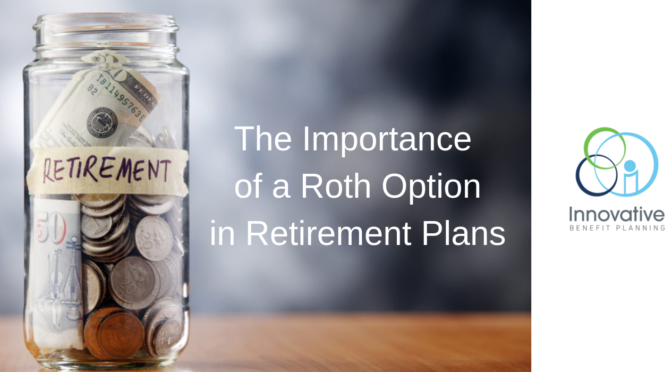The Importance of a Roth Option in Retirement Plans

Roth contributions can provide significant benefits to retirement plans for both participants and plan sponsors alike. But what does Roth mean? Unlike pre-tax, Roth refers to post-tax dollars, meaning the money has already been taxed when it goes into a participant’s account. They are beneficial to participants because qualified Roth distributions are taken tax-free. Plan sponsors benefit from the after tax feature because it offers flexibility in how participants can save which improves employee retention, particularly with younger employees. 63% of 401(k) plans in the United States offer a Roth feature for participants within the plan3 .
Plan sponsors that offer a Roth option allow their participants to perform tax diversification. Simply put, participants can be more flexible with how they save for retirement. Tax diversification refers to the allocation of an individual’s investments into different account types based on their tax characteristics1. This flexibility in saving will help an organization be more competitive when attracting and retaining talent. When an individual contributes post-tax (Roth) dollars into a qualified Roth account, qualified distributions will not be subject to any tax because the tax liability was satisfied before the money was contributed.
The dilemma most people experience is that they typically cannot anticipate what tax bracket they will be in during retirement. If participants believe they will be in a higher tax bracket in retirement, Roth contributions will be beneficial because they will pay tax when they are in a lower tax bracket and have a lower overall tax liability. Pre-tax contributions are beneficial when participants believe they will have a lower tax bracket in retirement than in their earning years. The more tax-deferred income a person takes in retirement, the higher their tax bracket will likely be; making Roth withdrawals more advantageous. If participants have only Roth investment income for retirement, they will likely find themselves in a lower tax bracket; making tax-deferred income advantageous. One solution is to find a balance between tax-deferred withdrawals and Roth withdrawals2. Participants can take tax deferred withdrawals until they reach the limit of their tax bracket and then switch to taking Roth withdrawals before moving into the next tax bracket.
401(k) plans a highly customizable. Adding a Roth feature can improve participant’s ability to save for retirement in a matter that best suits them but may not make sense in every plan. Innovative Investment Fiduciaries advises on nearly 60 qualified and non-qualified retirement plans. Our team of plan experts can help plan sponsors decide if adding a Roth component to their company’s 401(k) plan makes sense for them.
1 The Balance – Tax Diversification and Investing
https://www.thebalance.com/tax-diversification-with-investing-2466705
2 Oblivious Investor—Tax Diversification: Roth IRA vs. Traditional IRA
https://obliviousinvestor.com/tax-diversification-roth-ira-vs-traditional-ira/
3 2016 PCSA Survey – (have the survey on file but cannot find it online)
4Investor Words – Qualified Distribution — http://www.investorwords.com/12253/qualified_distribution.html
About Innovative
Innovative Benefit Planning is an employee benefit planning and financial services company that combines innovation with integrity for companies nationally and internationally. Our people and experience, coupled with sound financial advisory services, have helped thousands of organizations and their employees achieve their employee benefit planning goals and more. Our focus is on creating comprehensive, custom plans that deliver better, cost-saving techniques and manage it all for you with our highly skilled support team. “Putting People First” ibp1.wpengine.com (888) 427-7383
Categories
Archive








